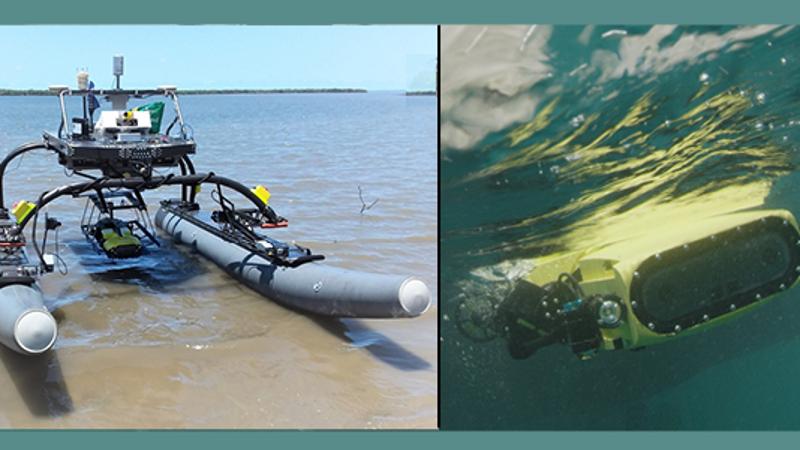
Every great superhero story has its hero and trusted side-kick.
Enter, Bruce and Thunder4: a robotic duo about to take on the world in the coveted biennial competition, Maritime RobotX Challenge (8-15 December) in Hawaii.
With robotic vision as its superpower, the Autonomous Surface Vehicle or “robo-boat” known as Bruce is the creation of a QUT student team under the guidance of Australian Centre for Robotic Vision Chief Investigator and QUT Professor Matthew Dunbabin.
The team has entered the challenge since it started in 2014 and was placed second in 2016.
Despite again lining up as one of the smallest teams – overshadowed by 2016 victor, the University of Florida, with a 27-member team and five support staff – Team QUT, supported by the Australian Centre for Robotic Vision, is buoyed by a passion to claim victory in a field of 15 teams from six Pacific Rim countries (United States of America, China, Japan, Singapore, Taiwan and Australia).
Not for victory’s sake (or prizemoney), but advancement of autonomous vehicle technology in the maritime environment.
“This competition offers a fantastic technical opportunity for students to network and gain exposure to an incredibly important industry that is all about saving lives, moving freight and protecting natural environments,” says Professor Dunbabin.
“Ongoing advances in autonomous maritime vehicles or ‘robo-boats’ will be important in real-world emergencies, enabling search-and-rescue missions in all conditions, particularly when human-led efforts are thwarted by dangerous or risky scenarios.”
Importantly, this year, Maritime RobotX Challenge organisers have introduced a new requirement for competitors to construct a ‘System of Systems’ with craft operating in multiple domains, including the ability to sense and act underwater.
Here, RangerBot2 – one of five superhero marine robots created by Professor Dunbabin – has been modified to step up as Bruce’s trusted sidekick aka Thunder4.
In Hawaii, the modified RangerBot will be put to work as the team’s eyes beneath the water, while Bruce plays the lead role as ‘robo mother ship’. That is, a 16-foot WAM-V (Wave Adaptive Modular Vessel) provided as a shell to each team (ahead of the competition) to fit with a system of sensors, software and hardware that work together to enable its autonomous capabilities.
“In addition to fully autonomous movement, Bruce must be smart enough to make decisions regarding navigation and mapping,” Professor Dunbabin said.
“On-board intelligence developed by the team, enabling it to successfully perform tasks like obstacle avoidance; signal recognition, including reading light sequences to determine whether to dock or circle buoys in a certain direction; obstacle detection; and recovery of objects located above and below the water’s surface. All without human intervention.
“And that’s without taking into account bad weather. At the last RobotX, we came up against 20 knot winds, waves and difficult lighting conditions – not that we’re complaining as that’s the kind of test needed to replicate the real world.”
As for the inspo behind RangerBot’s alter ego, Thunder4, playing cameo to Bruce?
“Thunderbird 4, of course! The underwater rescue vehicle in Thunderbirds,” said Dr Dunbabin of the cult British sci-fi classic, set in the 2060s, following the adventures of International Rescue, a life-saving organisation equipped with technologically advanced land, sea, air and space rescue craft.
“RangerBot, like Thunderbird 4, is the same superhero yellow and has its own superpower of robotic vision.
“What’s worrying, however, is some of my young PhD students haven’t heard of Thunderbirds. So, clearly I’ve got a bit of educating to do.”
The student team fly to Honolulu this week to join Bruce, Thunder4 and third bot, Gusto (a custom racquet ball launcher), in the 2018 Maritime RobotX Challenge.
This year marks the third time the competition has been held. Organised by RoboNation and Navatek, with funding support from the US Office of Naval Research, it takes place on Sand Island, Oahu.
Visit www.robotx.org for details of a live webcast of the Finals on 15 December and keep an eye out for more news on the Centre website.
Meet Team QUT and their robotic-vision empowered bots: http://www.teamqut.com/
MEDIA CONTACT: media@qut.edu.au I After hours +61 407 585 901
ARC Centre of Excellence for Robotic Vision: shelley.thomas@qut.edu.au I P +61 7 3138 4265 M +61 416 377 444


